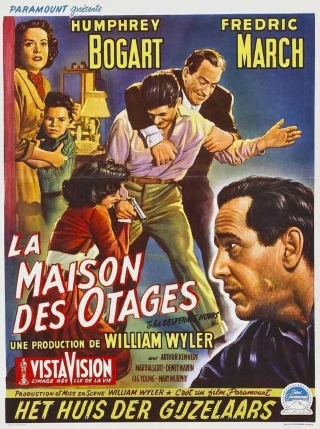Humphrey Bogart’s penultimate film offered him the chance to have one final crack at the kind of role that had catapulted him into the public consciousness two decades earlier. The Petrified Forest (1936) gave Bogie his big break, but it also led to his being typecast as the one dimensional heavy. For the next five years he wasn’t called on to do much more than sneer at the camera and get shot by James Cagney. Playing Roy Earle in Raoul Walsh’s High Sierra would be the turning point for him – sure it was another doomed gangster part but at least this one had a human face. With one exception, he avoided any more underworld roles until we come to 1955 and The Desperate Hours.
The story concerns Glenn Griffin (Bogart) who, in the company of kid brother Hal (Dewey Martin) and lumbering sociopath Kobish (Robert Middleton), has just broken out of prison. Needing somewhere to lay up until Glenn’s girl can reach them and deliver their money, the trio take over the suburban home of Dan Hilliard (Fredric March) and hold the family hostage. There is also a side matter of Griffin holding a grudge against a local cop (Arthur Kennedy), but this is never really developed as the movie chooses to focus on the clash of those cinematic titans Bogart and March. What we get is a war of will and wits between Bogart’s career criminal, struggling to maintain control over both his companions and the family, and the steadfast and respectable March. The film was adapted from a stage play and much of the drama is played out within the confines of the family home. This both points up the contrast between the snug domesticity of the Hilliards and the violent Griffin gang, and helps highlight the claustrophobic sense of entrapment felt by all the principals. As the balance of power seesaws back and forth, the atmosphere of tension never lets up until the film reaches its satisfying climax.
Films which are adapted from plays almost always give actors a chance to show what they’ve got. Such is the case with The Desperate Hours, where two of the heavyweights of classic era Hollywood get to slug it out and ultimately share the spoils. By this stage in his career Bogart could play this type of role in his sleep. Glenn Griffin is a man on the edge, battling to maintain control over those around him and his own personal demons. It is his failure to control either his cohorts or his own thirst for vengeance that finally bring him down. In contrast, March’s Dan Hilliard is the epitome of middle American stoicism, never allowing any overt signs of weakness or doubt to be witnessed by his family. Where Griffin’s dependence on violence and threats leads to fatal blunders, Hilliard’s self discipline and decency allow him to coolly wait for his chance. Of the support cast, the parts of Arthur Kennedy and Gig Young are thanklessly underwritten; the former having little to do except show his dogged professionalism and the latter his devotion to the Hilliard’s daughter. Robert Middleton fares best as the stupid and dangerous Kobish. He brings a genuine sense of menace to the film as his character literally crashes around like a bull in a china shop. There are also small yet welcome parts for character specialists Whit Bissell and Ray Teal.
The Desperate Hours is available on DVD in both R1 and R2 from Paramount. The disc is a totally barebones affair but the widescreen anamorphic transfer is fantastic and, at the time of writing, can be picked up for less than a fiver. All in all, it’s a worthwhile and recommended movie.

Really liked your coverage of this all-too ignored late Bogart title. “The Desperate Hours” chilled me to the bone when I first saw it on NBC “Saturday Night At The Movies” in 1965 at the age of eleven. I wondered when escaped convicts might be invading our home for some time thereafter. Wait a minute, they might STILL be out there!
LikeLike
Thanks.
What’s more worrying is there may be a more ruthless breed still out there 😉 .
LikeLike
This is my favorite Bogart film by far. I loved the ending where March is practically throwing Bogart down the stairs. Top notch acting in this one for sure!
LikeLike
Bogart’s late career roles tended to be a little patchy, but there were some good ones mixed among the more humdrum stuff.
LikeLike
Back in the 80’s one of the local cinemas used to show quite a few Bogart films. Mostly 16 mm I believe, and I caught this one on a double bill with Maltese Falcon. Great stuff. Too bad the cinema could not make a go with the older format and switched to current products. Your review is again right on target.
LikeLike
There’s something of a buzz to be had from seeing classic movies projected on the big screen to an audience. It’s an experience I’ve enjoyed a number of times and I still get a kick out of it.
LikeLike
Yes, I agree. The last noir saw on a big screen were DETOUR and REAR WINDOW.
LikeLike
I’ve seen a good many Hitchcock films projected, probably close to a dozen or thereabouts.
LikeLike
Pingback: The Law and Jake Wade | Riding the High Country
Pingback: Hell’s Island | Riding the High Country
Pingback: Hannah Lee | Riding the High Country